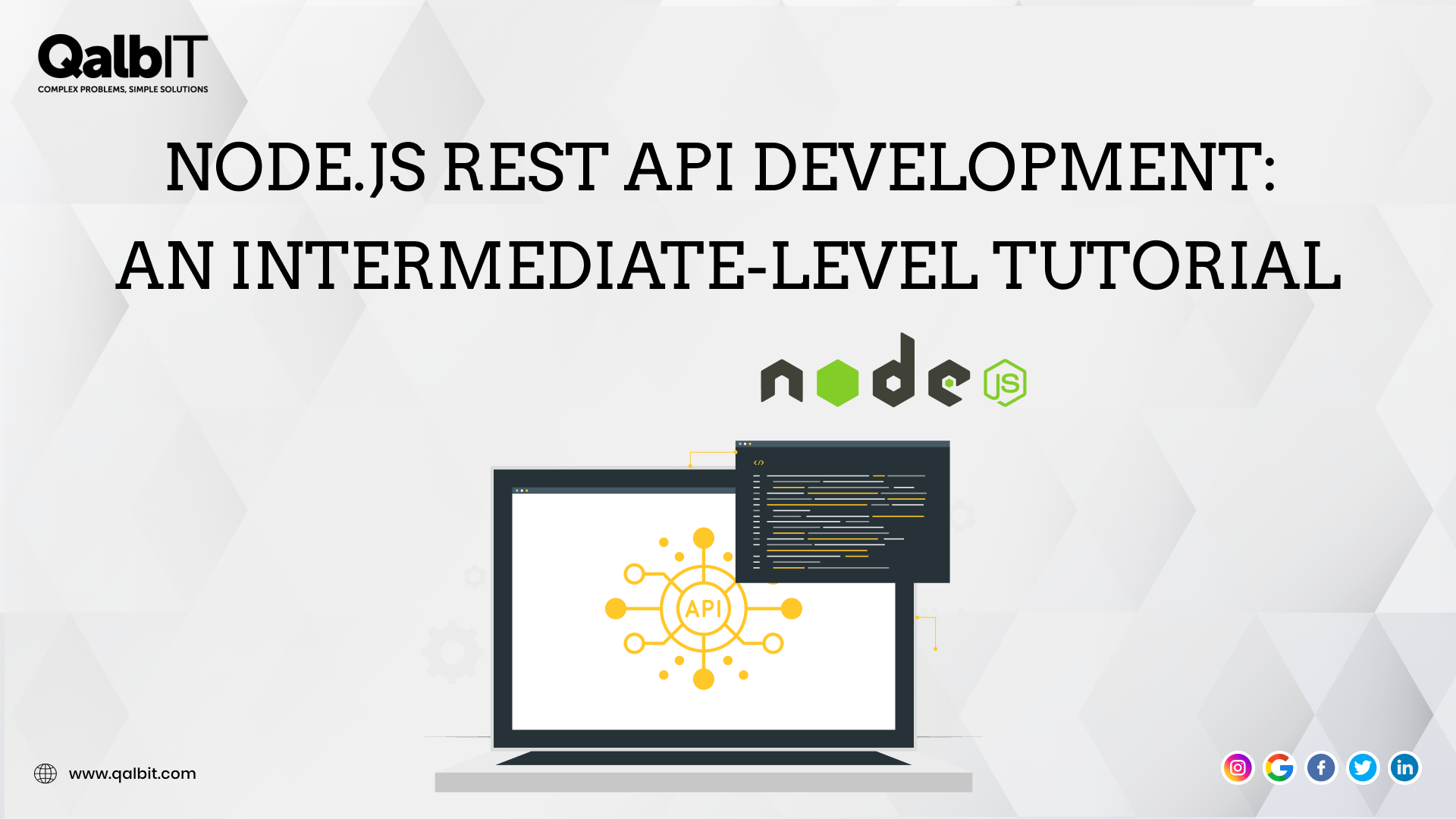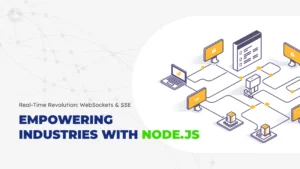
This blog provides a complete framework for developing a REST API using Node.js. The tutorial covers all phases of the API development process, from planning and designing to testing, documenting, deploying, monitoring, and securing. We will discuss key topics such as API design principles, middleware, caching, scaling, and security considerations, providing a great resource for developers wishing to construct high-performance and safe REST APIs.
I. Introduction
REST API is the backbone of modern web development. They allow apps to communicate with each other through the internet, allowing access to data and functionality. In this post, we’ll show you how to construct a REST API using Node.js.
Node.js is a great tool for building high-performance, scalable applications. It has a non-blocking I/O model that allows it to manage a high number of connections at once, making it excellent for constructing REST APIs. This guide is intended at developers who have some expertise with Node.js and want to learn how to construct REST APIs.
II. Planning and Developing the API
Before you start constructing your API, you need to plan and design it. This comprises gathering requirements, analyzing the data and functionality you need to offer, and building the API architecture.
1. API design concepts
There are various API design rules that you should be aware of while designing a REST API. They include
- HATEOAS: Hypermedia As The Engine Of the Application State, which indicates that the API should give links to similar resources so that clients can explore the API.
- Hypermedia: The API should employ hypermedia formats like JSON HAL or JSON API to provide additional information about resources and their relationships.
- OpenAPI specification: This is a standard for describing REST APIs. You should write an OpenAPI definition for your API so that customers may readily understand its structure and usage.
2. API requirements gathering and analysis
You should start by gathering requirements for your API. This involves examining the data and functionality you need to expose, and establishing how clients will interact with your API.
For example, if you’re designing an e-commerce API, you might need to include endpoints for generating and modifying orders, managing user accounts, and accessing product information.
3. API architecture, resource modeling, and security considerations
Once you have your requirements, you can start building the API architecture. This entails defining a resource model for your API, which describes the data and capabilities you need to expose.
You should also consider security aspects, such as how to authenticate users and protect against attacks like SQL injection or cross-site scripting.
4. Developing an OpenAPI standard for the API
An OpenAPI specification provides a standardized means of expressing your API. It offers information such as the API endpoints, request and response schemas, and example payloads.
There are various tools for producing an OpenAPI specification, including Swagger and OpenAPI Generator.
III. Developing and Testing the API
After you have your API design in place, you can start constructing and testing your API.
1. Setting up the development environment
You should start by setting up your development environment. One method to do this is by utilizing Docker, which allows you to containerize your application and dependencies, making it easier to deploy and test.
2. Building the API using Node.js, Express, and MongoDB
Node.js and Express are great for constructing REST APIs, providing a fast and efficient approach to handling HTTP requests and responses.
MongoDB is a popular NoSQL database that is widely used with Node.js applications. It provides a versatile data model and is well-suited to processing massive amounts of data.
Here’s an example of a simple API endpoint in Express:
const express = require('express');
const app = express();
app.get('/api/users', (req, res) => {
// Return a list of users
});
app.listen(3000, () => {
console.log('Server started on port 3000');
});3. Building middleware and authentication techniques to safeguard the API
Middleware functions are functions that are executed before the request handlers in Express. Middleware methods can be used to implement authentication, logging, error handling, and other functionality in your API.
To develop middleware methods and authentication techniques to safeguard your API, follow these steps:
- Build a middleware function that validates the access token in the Authorization header of the request.
- Build an authentication system, such as OAuth2, JWT, or Basic Authentication, that creates and validates access tokens.
- Employ the middleware function and authentication method in the API endpoints that require authentication.
4. Providing complex API capabilities, such as pagination, caching, and rate limiting
Advanced API features can increase the performance and scalability of your API. Some of the sophisticated features you can build include pagination, caching, and rate limitation.
To develop these advanced API features, follow these steps:
- Implement pagination by using the skip() and limit() methods in the MongoDB query for obtaining resources.
- Add caching by utilizing a caching middleware like Redis or Memcached to store the responses of frequently requested API endpoints.
- Install rate limitation by utilizing a rate-limiting middleware like express-rate-limit to limit the number of requests per IP address or per user.
5. Creating unit tests and integration tests for the API
Testing is an important aspect of the software development process. Unit tests and integration tests can assist you to check that your API is functioning as expected and that modifications to the API do not generate regressions.
To write unit tests and integration tests for your API, follow these steps:
- Employ a testing framework like Mocha or Jest to develop unit tests for specific functions and modules in your API.
- Employ a testing framework like Supertest or Chai-HTTP to develop integration tests for the API endpoints.
- Employ a mocking framework like Sinon or Testdouble to mock dependencies and other services in your API tests.
IV. Documenting the API
Documentation is a vital element of any REST API development process. It is necessary to provide clear and comprehensive documentation that defines how the API works, its endpoints, request, and response schemas. Effective documentation helps developers understand how to use the API correctly, enhances communication across teams, and gives a reference point for debugging.
1. Significance of API Documentation
Proper API documentation helps in the following ways:
- It allows developers to grasp the API’s functionality, data formats, error codes, and endpoint URLs.
- It assists in faster and simpler adoption of the API by new developers.
- It enhances communication and collaboration between teams.
- It gives a reference point for troubleshooting and testing.
2. Documenting the API endpoints, request, and response schemas
To generate thorough documentation, you need to provide the following details:
- List of endpoints and their HTTP methods
- Description of each endpoint
- Needed input parameters for each endpoint
- Optional settings for each endpoint
- Possible output values
- Potential error codes and their meanings
- Example request and response payloads
3. Generating API documentation using tools like Swagger or ReDoc
Technologies like Swagger and ReDoc can aid in automatically generating API documentation. These tools can read the OpenAPI specification and provide interactive documentation for your API.
Here’s an example of how to generate documentation using Swagger:
1. Install the Swagger UI package using npm:
npm install swagger-ui-express2. Write a Swagger specification file (swagger.json) that explains your API.
3. In your Node.js application, import the swagger-ui-express package and use it to provide the Swagger UI from a specified URL:
const express = require('express');
const swaggerUi = require('swagger-ui-express');
const swaggerDocument = require('./swagger.json');
const app = express();
app.use('/api-docs', swaggerUi.serve, swaggerUi.setup(swaggerDocument));
app.listen(3000, () => {
console.log('Server listening on port 3000');
});This code will provide the Swagger UI at the URL http://localhost:3000/api-docs.
4. You can now access the Swagger UI by visiting the URL in your web browser.
V. Deploying and Monitoring the API
After building and testing the API, the next step is to deploy it to a production environment and monitor its performance. There are various deployment choices for Node.js APIs, including AWS, Azure, and Google Cloud Platform. You may also utilize containerization tools like Docker to deploy your API.
1. Explaining the deployment choices for Node.js APIs
- There are various deployment options for Node.js APIs, including:
- Cloud platforms like AWS, Azure, and Google Cloud Platform
- Virtual private servers (VPS) like DigitalOcean or Linode
- Managed Node.js hosting platforms like Heroku or Now
- Containerization technologies like Docker and Kubernetes
2. Setting up a Continuous Integration and Continuous Deployment (CI/CD) pipeline for the API
A CI/CD pipeline automates the process of building, testing, and delivering your API. The pipeline ensures that any modifications to the API are automatically tested and deployed to a production environment.
Here’s an example of how to build up a CI/CD pipeline using GitHub Actions:
1. Create a new GitHub repository for your API.
2. Create a workflow file (.github/workflows/main.yml) that describes the CI/CD pipeline:
name: CI/CD Pipeline
on:
push:
branches:
- master
jobs:
build:
runs-on: ubuntu-latest
steps:
- name: Checkout code
usesV. Deploying and Monitoring the API
Once the API has been constructed and tested, the next step is to deploy it to a production environment. There are various deployment options for Node.js APIs, including:
- Deploying to a cloud platform like Amazon, Azure, or Google Cloud Platform
- Deploying to a container orchestration platform like Kubernetes
- Deploying to a serverless platform like AWS Lambda or Azure Functions
Regardless of the deployment choice, it’s vital to set up a Continuous Integration and Continuous Deployment (CI/CD) pipeline to automate the development, testing, and deployment process. This ensures that any modifications to the codebase are rapidly and reliably delivered to the production environment.
Once the API is implemented, it’s crucial to monitor its performance and availability using tools like New Relic or Datadog. These tools can provide insights into the API’s response times, error rates, and other metrics that can help discover performance issues and assure high availability.
VI. Performance Optimization and Scaling
REST APIs might be a performance impediment if not optimized properly. Some frequent performance concerns in REST APIs include:
- Excessive delay due to network overhead
- Huge response payloads that cost bandwidth and increase latency
- Excessive database queries that impede response times
To optimize the performance of a REST API, numerous strategies can be used:
- Caching: Cache frequently requested data to reduce the number of calls to the database
- Compression: Compress response payloads to reduce network overhead
- Request batching: Aggregate many queries into a single request to reduce network overhead
- Load balancing: Spread incoming requests across many servers to accommodate large traffic amounts
Scaling the API horizontally is also crucial to accommodating huge traffic levels. Technologies like Kubernetes and load balancing can assist scale the API by splitting incoming requests across multiple servers.
VII. Security Considerations
Security is a vital factor for any REST API. Some common security vulnerabilities to REST APIs include:
- SQL injection: Malicious SQL statements are injected into the API to get unauthorized access to the database
- Cross-Site Scripting (XSS): Malicious scripts are injected into the API to execute unauthorized actions on the client-side
- Cross-Site Request Forgery (CSRF): Malicious requests are sent to the API to execute unauthorized activities on behalf of the user
To minimize these security vulnerabilities, numerous security best practices can be implemented:
- Input validation: Verify all user input to ensure that it fits specified formats and lengths
- Encryption: Encrypt sensitive data in transit and at rest using industry-standard encryption techniques
- Access control: Install access control techniques to guarantee that only authorized users can access sensitive data and functionality
Testing the API for vulnerabilities with tools like OWASP ZAP and Burp Suite might help uncover potential security problems before they can be exploited.
VIII. Conclusion
In conclusion, implementing a REST API with Node.js takes careful design and attention to detail. By following best practices for API design, development, documentation, deployment, monitoring, performance optimization, and security, developers may build high-performing, scalable, and secure REST APIs that satisfy the needs of their consumers.
There are various Node.js modules and frameworks available for constructing REST APIs, and developers should choose the ones that best meet their project requirements. By consistently learning and experimenting with new technologies and methodologies, developers can remain ahead of the curve and build cutting-edge REST APIs that give value to their consumers.
Want to create your Web application, Let’s Connect!
Frequently asked questions
Middleware in a Node.js REST API functions as a bridge between the client and server, allowing for additional functionality such as authentication or logging.
GraphQL and microservices are popular alternatives to REST APIs. GraphQL enables for more efficient queries and eliminates over-fetching, while microservices allow for better scalability and adaptability.
Testing a Node.js API can be done through writing unit and integration tests using tools such as Jest or Mocha.
Microservices architecture can be used to construct REST APIs by splitting down the application into smaller, independently deployable services.
GraphQL is a query language that enables more flexible queries and efficient data retrieval, while REST APIs have a more strict structure but are easier to cache and manage massive amounts of data.






